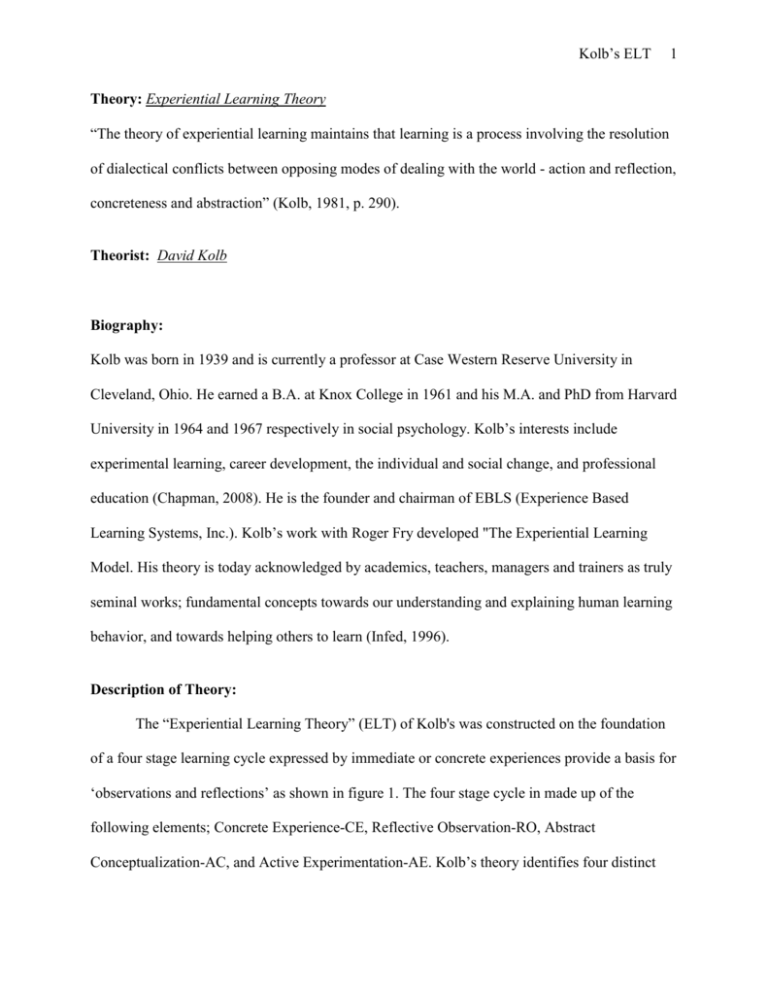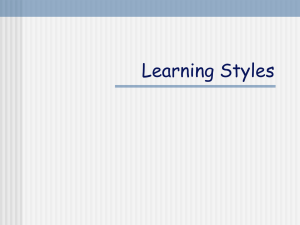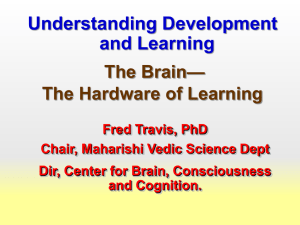Kolb's Experiential Learning Theory (ELT) Explained
advertisement

Kolb’s ELT 1 Theory: Experiential Learning Theory “The theory of experiential learning maintains that learning is a process involving the resolution of dialectical conflicts between opposing modes of dealing with the world - action and reflection, concreteness and abstraction” (Kolb, 1981, p. 290). Theorist: David Kolb Biography: Kolb was born in 1939 and is currently a professor at Case Western Reserve University in Cleveland, Ohio. He earned a B.A. at Knox College in 1961 and his M.A. and PhD from Harvard University in 1964 and 1967 respectively in social psychology. Kolb’s interests include experimental learning, career development, the individual and social change, and professional education (Chapman, 2008). He is the founder and chairman of EBLS (Experience Based Learning Systems, Inc.). Kolb’s work with Roger Fry developed "The Experiential Learning Model. His theory is today acknowledged by academics, teachers, managers and trainers as truly seminal works; fundamental concepts towards our understanding and explaining human learning behavior, and towards helping others to learn (Infed, 1996). Description of Theory: The “Experiential Learning Theory” (ELT) of Kolb's was constructed on the foundation of a four stage learning cycle expressed by immediate or concrete experiences provide a basis for ‘observations and reflections’ as shown in figure 1. The four stage cycle in made up of the following elements; Concrete Experience-CE, Reflective Observation-RO, Abstract Conceptualization-AC, and Active Experimentation-AE. Kolb’s theory identifies four distinct Kolb’s ELT 1 learning styles; Diverging, Assimilating, Converging, and Accommodating. These learning styles represent a combination of preferred styles and are based on the four stage learning cycle. Diverging (CE/RO) Assimilating (AC/RO) Converging (AC/AE) Active Experimentation (AE) The Diverger has been classified as a problem solver. This type of learner views situations through many lenses and relies heavily on brainstorming and generation ideas. (Kolb, 1979) An Assimilator learner has been considered as a problem solver by inductive reasoning. (Kolb, 1979) The Converger has been classified as a learner who wants to be a problem solver and relies on hypothetical deductive reasoning. (Kolb, 1979) Finally the Accommodator has been classified as a problem solver by implementing plans and experiments. (Kolb, 1979) “Kolb's model is particularly elegant, since it offers both a way to understand individual people's different learning styles, and also an explanation of a cycle of experiential learning that applies to us all” (Chapman, 2008). According to Kolb’s learning styles chart, learners cycle or “touch all the bases” through experiencing, reflecting, thinking, and acting. Immediate or concrete experiences lead to observations and reflections. “These reflections are then assimilated (absorbed and translated) into abstract concepts with implications for action, which the person can actively test and experiment with, which in turn enable the creation of new experiences” (Chapman, 2008). Kolb’s ELT 1 Kolb believed that people naturally prefer a single learning style influenced by factors based on the individuals learning style. The theory defines three stages of a person's development, and suggests that individual tendencies to resolve and incorporate different learning styles improve as they develop through each stage. Kolb’s developmental stages listed according to Chapman (2008): 1. Acquisition - birth to adolescence - development of basic abilities and 'cognitive structures' 2. Specialization - schooling, early work and personal experiences of adulthood - the development of a particular 'specialized learning style' shaped by 'social, educational, and organizational socialization' 3. Integration - mid-career through to later life - expression of non-dominant learning style in work and personal life (p. 4). Theory Measurement/Instrumentation: Kolb (1976) states, “We have developed a brief self-descriptive inventory called the Learning Style Inventory (LSI) to measure differences in learning styles along the two basic dimensions of abstract-concrete and active-reflective” (p.1). The Kolb LSI is a twelve item questionnaire and workbook developed by Kolb. The instrument is based on the ELT and identifies an individual’s preferred learning style. The instrument explores problem solving, teamwork, conflict resolution, communication network or it held, and career choice. The instrument can also be used for self knowledge so that individuals can understand and manage learning styles. For facilitators and educators, this instrument can be used to design various curriculum and content with the students learning style preferences in mind. Kolb’s ELT 1 The instrument is statistically reliable and valid and can be purchased on-line at http://www.haygroup.com/tl/Questionnaires_Workbooks/Kolb_Learning_Style_Inventory.aspx for $15 for a single user or set of 10 for $105. The instrument has been published in several languages and takes approximately 20-30 minutes to complete. Report Prepared by: Gary Dotterer References Chapman, A., (2008). Kolb Learning Styles. Retrieved September 12, 2008, from http://www.businessballs.com/kolblearningstyles.htm Infed. (1996). David a. Kolb on experiential learning. Retrieved September 12, 2008, from: http://www.infed.org/biblio/b-explrn.htm Kolb, D. (1981). Experiential learning theory and the learning style inventory: A reply to Freedman and Stumpf. Academy of Management. The Academy of Management Review (pre-1986), 6(000002), 289. Retrieved September 12, 2008, from ABI/INFORM Global database. Kolb, D. A., Rubin, I.M., and McIntyre, J.M (1979), Organizational Psychology, A Book of Readings. Kolb’s ELT Figure 1. Kolb’s Learning Styles diagram Chapman, (2008). http://www.businessballs.com/kolblearningstyles.htm © concept David Kolb, adaptation and design Alan Chapman 2005-06, based on Kolb's learning styles, 1984 Not to be sold or published. More free online training resources are at www.businessballs.com. 1






